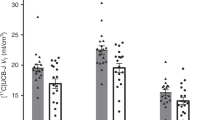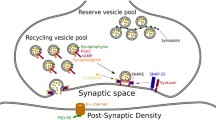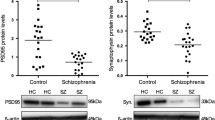Summary.
Although the psychotic symptoms in schizophrenia can be alleviated by treatment with dopaminergic receptor antagonists, the etiology and underlying neurochemical pathology remains obscure. Both neuropathological and magnetic resonance imaging studies have found evidence for neuronal loss and atrophy in the thalamus in schizophrenia, implicating this key structure for gating information to cortical areas in the pathophysiology. Recent studies have also found evidence of synaptic loss in the thalamus in schizophrenia. To further examine possible synaptic disturbances, we studied the synaptic related protein rab3a as a marker for synaptic density, using both quantitative Western blotting and immunohistochemistry. The material consisted of brains from 22 schizophrenic patients (mean age 79.3 years), and 24 control subjects (74.8 years). Reduced rab3a protein levels were found in the left thalamus in schizophrenia (0.47 ± 0.17 vs. 1.00 ± 0.18; p < 0.0001), while a less marked decrease was found also in the right thalamus (0.75 ± 0.13 vs. 1.00 ± 0.09; p < 0.0001). Immunohistochemistry, performed on two schizophrenic and two control brains, revealed that rab3a immunoreactivity was most reduced in the left anterior and mediodorsal thalamic nuclei. Therefore, we extended the study to brain regions connected these thalamic nuclei. Reduced rab3a protein levels were found schizophrenia also in the frontal cortex, hippocampus, gyrus cinguli, and parietal cortex, while no significant differences were found in the temporal cortex, or in cerebellum. The reduction in rab3a was not found to be secondary to confounding factors such as age-differences, post-mortem delay time, generalized brain atrophy, or antipsychotic medication. Therefore, the reduction of rab3a probably reflects synaptic disturbances, possibly synaptic loss, in the limbic system and neocortical areas, in schizophrenia. This part of the brain is known to be in-volved in behavioral and emotional control, and thus to be crucial for higher mental functions, suggesting that synaptic disturbances in the limbic system may be of importance in the development of psychotic symptoms in schizophrenia.
Similar content being viewed by others
Author information
Authors and Affiliations
Additional information
Received September 7, 1999; accepted January 13, 2000
Rights and permissions
About this article
Cite this article
Blennow, K., Bogdanovic, N., Heilig, M. et al. Reduction of the synaptic protein rab3a in the thalamus and connecting brain regions in post-mortem schizophrenic brains. J Neural Transm 107, 1085–1097 (2000). https://doi.org/10.1007/s007020070054
Issue Date:
DOI: https://doi.org/10.1007/s007020070054




